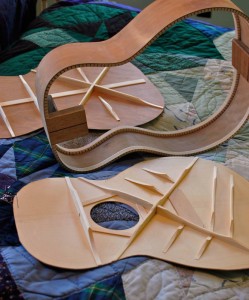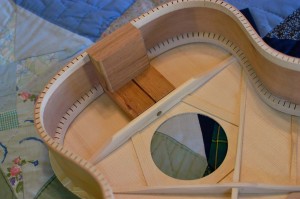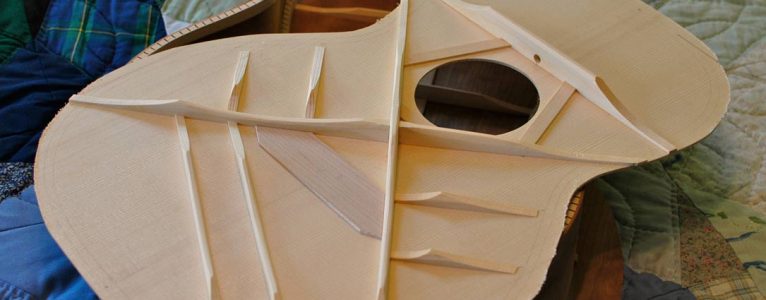 I’m about ready to close the boxes on my Orchestra & Auditorium prototypes and thought I would share a little bit about how they are coming together. I’m using Adirondack spruce tops with light and strong Adi bracing. I’m still amazed at how stiff this brace wood is, when properly cut. I’ve finished carving the braces for the tops and backs and the plates sound good. Here’s a little recording of the thump test.
I’m about ready to close the boxes on my Orchestra & Auditorium prototypes and thought I would share a little bit about how they are coming together. I’m using Adirondack spruce tops with light and strong Adi bracing. I’m still amazed at how stiff this brace wood is, when properly cut. I’ve finished carving the braces for the tops and backs and the plates sound good. Here’s a little recording of the thump test.
For the record, I do think it important to get a nice, sustained tap out of the braced top, but I’m not entirely convinced that the tap tone of an unattached top (or back) really tells you much about the finished instrument. However, some builders swear by this kind of information, so I’m hedging my bets by keeping lots of data along the way. In a hundred guitars (give or take a few, ha ha), I hope to be able to look back and see how the data I’ve collected fits my impressions of the finished instruments.
In the meantime, data:
| Auditorium | Orchestra | |
|---|---|---|
| tap-tone (top) | B | B |
| tap-tone (back) | A | A♭ |
| top mass (g) without bracing | 190 | 170 |
| top mass (g) with bracing | 255 | 235 |
 I’m also trying a new neck joint with this pair. I’ve been using a good-fitting mortise and tenon joint between the body and neck and gluing the fingerboard extension down to the body. It makes a good-sounding joint that can be reset with a minimum of fuss, but I’ve been thinking about trying a fully-supported, completely bolt-on neck to further simplify neck resets, finishing and prevent the subtle hump at the neck/body joint most guitars develop with time. While looking into what other builders are doing, I ran across the blog of a friend of mine from college, Ben Le. He had some great photos of the bolt-on-only neck joint used at a guitar-building course he attended up in Vermont. This method uses a fairly thick neck block to help support the extension.
I’m also trying a new neck joint with this pair. I’ve been using a good-fitting mortise and tenon joint between the body and neck and gluing the fingerboard extension down to the body. It makes a good-sounding joint that can be reset with a minimum of fuss, but I’ve been thinking about trying a fully-supported, completely bolt-on neck to further simplify neck resets, finishing and prevent the subtle hump at the neck/body joint most guitars develop with time. While looking into what other builders are doing, I ran across the blog of a friend of mine from college, Ben Le. He had some great photos of the bolt-on-only neck joint used at a guitar-building course he attended up in Vermont. This method uses a fairly thick neck block to help support the extension.
I was intrigued, but wondered about securing the end of the tongue (with the logic that you might get unexpected results when adjusting the truss rod, since it would put a lot of pressure on that extension). Well, Trevor Gore beat me to it; he uses a four-bolt setup to lock the neck in place, two bolts at the tenon and two at the end of the fingerboard extension. I had drawn up a method that’s remarkably similar, at least on the surface, so I’m glad to see another builder’s already working along these lines.
